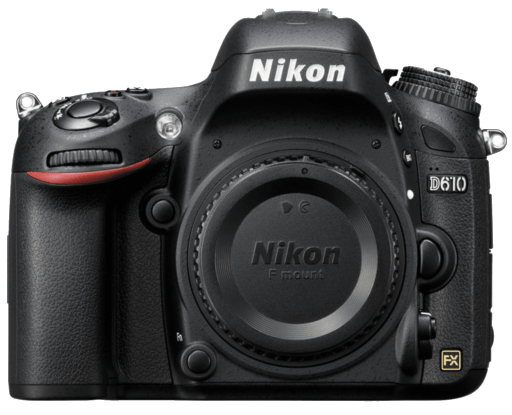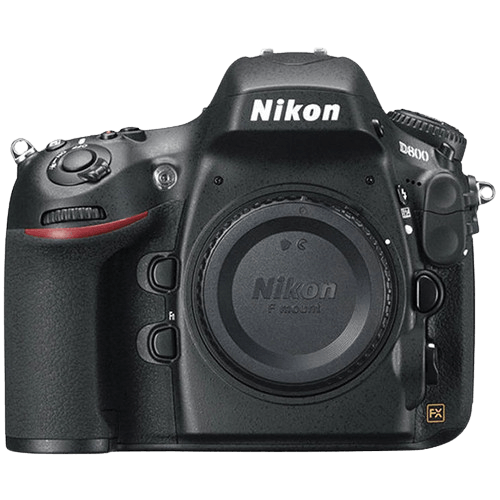Nikon D610 vs D800 Comparison
Nikon D610

Nikon D800

The Nikon D800 outperforms the Nikon D610 with a score of 69/100 compared to 66/100. Both cameras are DSLR models, announced in 2012 and 2013, respectively. They share identical depths of 82mm, but the D800 is larger, measuring 146 x 123mm, and heavier at 1000g. The D610, on the other hand, is more compact at 141 x 113mm and lighter, weighing 850g.
The D800’s higher score reveals its superiority in certain aspects, justifying its higher launch price of $2999 compared to the D610’s $1999. However, the D610’s smaller size and lighter weight offer advantages in terms of portability and convenience for photographers on the move.
Considering these factors, the Nikon D800 is the better camera in terms of performance, while the Nikon D610 offers a more travel-friendly option.
Nikon D610 vs D800 Overview and Optics
The Nikon D800 outperforms the Nikon D610 in optics with a score of 74/100, a 4-point difference from the D610’s score of 70/100. Both cameras share several common specifications, including a CMOS sensor, full-frame sensor size, Expeed 3 processor, Nikon F FX lens mount, and lack of image stabilization.
The D800’s advantage is primarily due to its higher megapixel count of 36.3, compared to the D610’s 24 megapixels. This increased resolution allows the D800 to capture more detail, resulting in sharper and more detailed images. Additionally, the D800 has a slightly higher DXOMARK score for its sensor, coming in at 95 versus the D610’s 94. This one-point difference suggests that the D800’s sensor provides marginally better image quality in terms of color depth, dynamic range, and low-light performance.
On the other hand, the Nikon D610 has a faster shooting speed of 6 frames per second (fps), compared to the D800’s 4 fps. This makes the D610 a better choice for capturing fast-moving subjects or action scenes where a faster burst rate is crucial.
To conclude, the Nikon D800 offers superior image quality due to its higher megapixel count and marginally better sensor performance. However, photographers who prioritize capturing fast action may find the Nikon D610’s faster shooting speed more suitable for their needs. Ultimately, the choice between these two cameras will depend on the specific requirements and preferences of the photographer.
Nikon D610 vs D800 Video Performance
When comparing the video capabilities of the Nikon D610 and the Nikon D800, both cameras come out as equals, with a video score of 57 out of 100. This means that no camera is a clear winner in terms of video performance.
The Nikon D610 and the Nikon D800 share common video specifications. Both cameras have a maximum video resolution of Full HD and video dimensions of 1920 x 1080. Additionally, both cameras have a maximum video frame rate of 30fps and feature built-in time-lapse functionality.
Given their identical scores and specifications, it is difficult to determine which camera is better in terms of video capabilities. Both cameras offer the same level of performance and functionality, making them suitable for various video recording needs.
However, it is essential to consider other factors beyond video capabilities when choosing between these two cameras. While the Nikon D610 and the Nikon D800 share similar video specifications, they may differ in aspects such as sensor size, image quality, and additional features. These differences may influence a photographer’s preference for one camera over the other.
In comparing the Nikon D610 and the Nikon D800, it is evident that their video capabilities are evenly matched. Both cameras offer Full HD resolution, 30fps frame rate, and built-in time-lapse functionality. As a result, neither camera stands out as a clear winner in terms of video performance. When making a decision, photographers should consider other factors beyond video capabilities to determine which camera best suits their needs.
Nikon D610 vs D800 Features and Benefits
The Nikon D610 and the Nikon D800 both have a feature score of 57/100. This indicates that they share many similar specifications when it comes to their features.
Both cameras have a 3.2-inch screen with a resolution of 921,000 dots. Neither camera has a touchscreen, flip screen, GPS, or Bluetooth. However, both cameras have WIFI capabilities.
There are no significant differences in features between the Nikon D610 and D800. Both cameras have the same screen size and resolution, which makes them equal in terms of display quality. The lack of a touchscreen, flip screen, GPS, and Bluetooth is common between the two models, which does not give either camera an advantage in this comparison.
While there are no significant advantages for either camera in terms of features, it is important to consider other aspects such as the general specifications, optics, and video capabilities when determining which camera is better suited for your needs. The Nikon D610 and D800 have equal feature scores, so it is crucial to evaluate other factors to make an informed decision.
In this comparison of features, neither the Nikon D610 nor the Nikon D800 outperforms the other. Both cameras share similar specifications and lack certain features that may be important to some users. As a result, potential buyers should assess their specific needs and preferences and consider other aspects such as general specifications, optics, and video capabilities before making a decision.
Nikon D610 vs D800 Storage and Battery
Both the Nikon D610 and Nikon D800 have an identical storage and battery score of 71/100. They share several common specifications, such as having two memory card slots, accepting SD/SDHC/SDXC memory cards, offering a battery life of 900 shots, utilizing the EN-EL15 battery type, and lacking USB charging capabilities.
The Nikon D800 has a slight advantage in storage options, as it is also compatible with Compact Flash cards and supports UHS-I for faster transfer speeds. This feature may benefit photographers who require flexibility in storage formats or faster data transfer capabilities.
On the other hand, the Nikon D610 does not offer any advantages in storage and battery over the Nikon D800. Both cameras perform equally well in these aspects, which indicates that users can expect similar reliability and storage capabilities from either model.
Ultimately, the Nikon D800’s compatibility with Compact Flash cards and UHS-I support make it a marginally better option for those prioritizing storage flexibility and speed. However, both cameras are equally reliable and efficient in terms of battery performance, making them suitable choices for most photography needs.
Nikon D610 vs D800 – Our Verdict
Are you still undecided about which camera is right for you? Have a look at these popular comparisons that feature the Nikon D610 or the Nikon D800:

